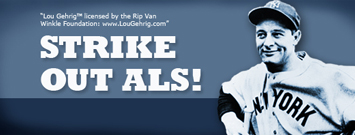Background Information on ALS

Amyotrophic lateral sclerosis (ALS), or Lou Gehrig’s disease, is a debilitating disease that can often be difficult to diagnose. ALS can mimic, or appear to be, many of debilitating diseases, and all of these must be ruled out before this diagnosis is handed out. Many of the diseases that could present like ALS have treatments, and possibly cures; ALS does not. The degeneration of upper and lower motor neurons is a characteristic of this disease, and due to the long diagnostic time, many patients are already in the late stage of this disease, and will likely die of respiratory failure in only a few years. ALS is most commonly thought of as a musculodegenerative disease, but there can also be cognitive declines as well.
Two forms of ALS are familial ALS (fALS) or sporadic ALS (sALS). sALS is much more common, but fALS is usually due to inherited genetic risk factors. This disease is thought to be partially caused from an accumulation of iron in the body. This will lead to increased amounts of reactive oxidative species (ROS), which will go into stress granules. The body will then attempt to get rid of the ROS, and thus will develop oxidative stress, which will lead to mitochondrial damage and/or RNA dysmetabolism. This will then lead to problems forming correct proteins, and cellular function, especially in large neurons, is impaired.
Treatments
As there is currently no cure for ALS, the goals of treatment are slowing the progress of the disease and/or reducing pain due to symptoms.
- Medications
- Riluzole: appears to slow disease’s progress, acts by reducing glutamate levels (stop brain from developing glutamate excitotoxicity, which damages neurons)
- Edaravone: was just approved this year, shows a reduced decline in daily functioning
- Other pain relief medications for treating the symptoms
- Therapies
- Physical therapy: address pain, walking, mobility, bracing, and equipment; practice low-impact exercises
- Breathing care: breathing devices if needed
- Occupational therapy: help to find ways to remain independent, modify home for accessibility
- Speech therapy: adaptive techniques to make speech more clear
- Nutritional support: eating foods that are easier to swallow, eventually may need a feeding tube
- Psychological and social support: financial help, insurance, getting equipment, emotional support
The Ice Bucket Challenge
One way ALS has gained attention as well as some funding was through the ice bucket challenge. This was a trend in which social media was utilized to raise awareness and funds for ALS through individuals doing their own challenge and then nominating others to do one as well. A timeline of this challenge can be found here. What started as a small gesture done by one man was able to race through the world due to the power of social media. Supporting those with ALS, as well as bringing awareness into communities is imperative in the fight against ALS.

